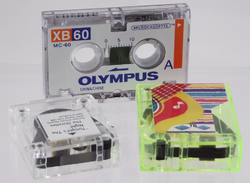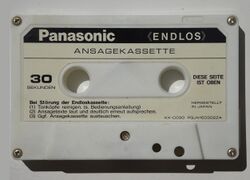Engineering:Endless tape cartridge
An endless tape cartridge is a tape cartridge or cassette that contains magnetic audio tape that can be played in an endless loop, without the need to rewind to repeat.
Description
The endless tape cartridge has a tape transport that allows forward movement only. The magnetic tape can have start and end markers, like a magnetic beacon, an electric conductive splice, a hole that can be optically scanned, or a transparent splice tape. The cartridge was invented by sound engineer Bernard A. Cousino and it dominated the North American market for many years.[1]
One of the first products that used the endless tape technology was the Audio Vendor from 1952, an invention of Cousino's.[2] It was registered as patent US2804401A. The tape is passed through an inner ring of loose tape reel, where the recording is stored, and looped back through the outer ring of the reel. Initially, this mechanism was to be implemented in a reel-to-reel audio tape recorder.[3][4]
Later, Cousino developed a plastic case that could be hung up on some existing tape recorders.[5] This cartridge was marketed by John Herbert Orr as Orrtronic Tapette.[6] In this generation, the magnetic coating of the tape was wound on the inside of the reel. Later cartridge types had the magnetic layer aligned to the outside of the cartridge, which required a specially designed recorder to play it. One traction of the tape by capstan was added, which allowed users the convenience of just pushing the cartridge into the recorder without having to thread the tape. These cassettes needed no internal space for the tape head slider because they accessed the tape from outside the cartridge.[7]
Based on these new cassettes, George Eash developed the Fidelipac cartridge in 1954.[8] PlayTape and the 8-track tape and endless compact cassettes for the announcement text of answering machines were made with this technique. The take-up roll got a table and the perforation for traction was removed.[clarification needed] There was no rear winding roll inside such a cassette so rewinding was impossible. Previously, a similar technique was used to store Tefifon's vinyl sonic tape in the Tefi cartridge.
Another invention patented by Cousino was the graphite coating applied to the bottom side of the tape in endless cartridges.[8][9][10] The coating allowed endless tape to be pulled out without crinkling it. 8-track cassettes also used the coating which caused the bottom side of the tape to be grey in colour.[11]
Technological predecessor of the endless cartridge
- Magnetic audio tape (1933)
- Tefifon (1936) – the vinyl sonic tape was similarly stored in the Tefi cartridge, but without any reel
- Audio Vendor – an assembly to install on a reel-to-reel tape recorder device by Bernard Cousino
- Stereo tape (1953) – first stereo audio storage for end users
List of endless tape cartridges
The different data and sound cartridges in chronological market launch order:
- 1950s: Orrtronic Tapette
- 1959: 3-track tape / Fidelipac / NAB-CARTridge "NAB-CART" / Rowe Customusic used the large C-type Fidelipac
- 1960: Rediffusion Reditune
- 1962: 4-track tape, also called Muntz Stereo-Pak or "CARtridge"
- 1960s: Mohawk Message Repeater Cartridge
- 1966: 8-track tape, also called Stereo-8 or 8-Track
- 1966: PlayTape
- 1967: SCM Mail Call, reused the Playtape cartridge
- 1969: endless compact cassette – for the announcement in answering machines
- 1971: HiPac,
- 1975: Ponkey, reused the HiPac cartridge
- 1983: ZX Microdrive Data Cartridge and tape drive – for data storage and backup
- ~1985: Bandai Micro Cartridge
- ~1987: Pocket Rockers
References
- ↑ "Cousino Cartridge Leads Tape Race" (in German), Billboard (Nielsen Business Media, Inc.): 24, 1956-02-25, https://books.google.com/books?id=pR4EAAAAMBAJ&pg=PA24, retrieved 2018-05-08
- ↑ Morton, David (2006) (in en), Sound recording: The life story of a technology, Baltimore, MD: Johns Hopkins University Press, p. 157, ISBN 0-8018-8398-9, https://books.google.com/books?id=0ZmjkJwxyWcC&pg=PA157
- ↑ (in German) Magnetic sound tape, 1955-04-11, https://patents.google.com/patent/US2804401A/en, retrieved 2018-05-02
- ↑ (in German) Audio, Radio Magazine, Incorporated, 1963, p. 83, https://books.google.com/books?id=josqAQAAMAAJ, retrieved 2018-05-08
- ↑ (in German) High Fidelity, Audiocom, 1973, p. 357, https://books.google.com/books?id=3WRLAAAAYAAJ, retrieved 2018-05-08
- ↑ (in German) Journal of the Audio Engineering Society, Audio Engineering Society., 1967, https://books.google.com/books?id=JixWAAAAMAAJ, retrieved 2018-05-08
- ↑ (in German) Tape cartridge, 1957-01-22, https://patents.google.com/patent/US2922642A/en, retrieved 2018-05-02
- ↑ 8.0 8.1 Kernfeld, Barry (2011) (in German), Pop Song Piracy: Disobedient Music Distribution Since 1929, Chicago / London: University of Chicago Press, p. 151, ISBN 978-0-226-43184-0, https://books.google.com/books?id=9AK28kNS4O0C&pg=PA151
- ↑ "Billboard" (in German), Billboard (Billboard Publications) 83: 134, January 1971, https://books.google.com/books?id=UfMiAQAAMAAJ, retrieved 2018-05-08
- ↑ (in German) Magnetic sound recording tapes, 1963-04-02, https://patents.google.com/patent/CA660361A/en, retrieved 2018-05-02
- ↑ "Frictionless Tape Ready" (in German), Billboard (Nielsen Business Media, Inc.) (28): 50, 1963-04-20, https://books.google.com/books?id=YQsEAAAAMBAJ, retrieved 2018-05-02
 |



